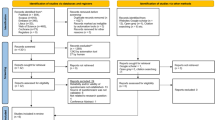Abstract
Data sources
ASSIA, EBSCO – CINAHL, Cochrane CENTRAL, EMBASE, ERIC, MEDLINE, SCOPUS, OpenGrey, Proquest – Social Services/ Sociological Abstracts, Web of Knowledge – Conference Proceedings Citation Index and ISI Science Citation/ Social Science Citation Index. There were no language restrictions and authors were contacted for primary data and additional information when required.
Study selection
Studies were considered eligible if they were primary studies of children (0 to 18 years) with confirmed oral neglect and with detail of dental, intra- and extra-oral features. Exclusion criteria included; studies of sexual or physical abuse or those where there was oral neglect suspected but no detail was given. All characteristics associated with dental neglect were considered outcomes.
Data extraction and synthesis
Each article was independently reviewed by two reviewers from a panel of 22 trained reviewers with a third reviewer resolving any disagreement. A specifically designed tool for quality assessment was used.
Results
Three thousand eight hundred and sixty-three citations and abstracts were scanned, 83 studies were reviewed and nine (with 1595 children aged 0 to 15 years) met the inclusion criteria, including two case control studies. There were not enough data to allow meta-analysis to be carried out.
The features most commonly recorded as being characteristics of dental neglect were; failure to seek, or delay in seeking dental treatment, failure to follow advice or complete treatment, and this often co-existed with an adverse impact of dental neglect on the child including pain and swelling. A ‘threshold’ level of dental caries, that allowed dental neglect to be defined, could not be established from the available literature.
Conclusions
There was limited literature on this topic. The main characteristics of dental neglect highlighted were failure/delay in seeking dental care, with adverse consequences. However, due to a lack of research and additionally, a deficiency in the data on precise clinical features, it was not possible to make the distinction between dental caries and dental neglect.
Similar content being viewed by others
Some clarification of trigger signs for dental neglect
Neglect is the most prevalent form of child abuse yet it is in itself a neglected topic, being superseded in the press by physical and sexual assault.1 Dental neglect can be defined as: ‘the failure of a parent or guardian to meet the child's basic oral health needs such that the child enjoys adequate function and freedom from pain and infection, where reasonable resources are available to family or caregiver.2
Health care professionals outside of the dental team, it seems, are reluctant to look inside children's mouths.1 Despite attempts to promote early identification of neglect through the Department of Health's ‘Child Protection and the Dental Team’ booklet, and the ‘Getting It Right For Every Child’ policy for Scotland, dentists have been reluctant to report suspected cases of neglect and abuse.
Likely reasons include lack of training or guidance and fear of impact on their practice, risk of litigation or family violence towards themselves or the child.3 Yet, dental professionals should be able to identify dental neglect, not only as a problem in itself, but also as it may be the first sign of general childhood neglect.4
This study was carried out by Core Info Cardiff Child Protection Systematic Reviews: an experienced team both in this clinical field and with systematic reviews.
Using a comprehensive literature search with strict inclusion criteria they identified nine articles outlining the common characteristics of dental neglect. These studies consistently reported that signs of dental neglect could include: failure to seek or a delay in seeking dental treatment; failure to follow dental advice; failure to administer medicine and provide basic oral care. Of these nine studies, none was set in the UK.
Six of the studies were North American and the remaining three from Italy, Sweden and Australia. Although all are Western cultures, there may be subtle differences in what is considered neglect between countries.
The review also addresses the difficult question; when does dental caries become dental neglect? Unfortunately, no evidence was found to support a definitive threshold number of lesions which, when reached, becomes a diagnosis of neglect. For example, one of the case studies included suggests that a diagnosis of early childhood caries should alert the clinician to the possibility of neglect. Yet this may only be an alert to a lack of knowledge or skills in the parent/caregiver rather than a neglectful attitude.
Although this systematic review clarifies the key signs to trigger consideration of dental neglect: failure to seek or a delay in seeking dental treatment; failure to follow dental advice; failure to administer medicine and provide basic oral care, more importantly it highlights what still needs to be done.
Development of a screening tool combining caries rate at that age, with some of the listed dental neglect characteristics, may be helpful. This could trigger an alert for higher risk families to be referred for multi-disciplinary team input of this complex issue.
-
Child dental neglect is an important topic for the dental team as it may be the first signs of general neglect.
-
Identifying neglect can be difficult; the clinician should familiarise themselves with the characteristics and refer if they have concerns.
References
Bradbury-Jones C, Innes N, Evans D, Ballantyne F, Taylor J . Dental neglect as a marker of broader neglect: a qualitative investigation of public health nurses' assessments of oral health in preschool children. BMC Public Health 2013; 13: 370.
Bhatia SK, Maguire SA, Chadwick BL, et al. Characteristics of child dental neglect: A systematic review. J Dent 2014; 42: 229–239.
Cairns AM, Mok JY, Welbury RR . The dental practitioner and child protection in Scotland. Br Dent J 2005; 199: 517–520.
Harris JC, Elcock C, Sidebotham PD, Welbury RR . Safeguarding children in dentistry: 2. Do paediatric dentists neglect child dental neglect? Br Dent J 2009; 206: 465–470.
Author information
Authors and Affiliations
Additional information
Address for correspondence: Dr S K Bhatia, University Dental Hospital, School of Dentistry, Cardiff University, Cardiff, CF14 4EA E-mail: bhatiask@cardiff.ac.uk
Bhatia SK, Maguire SA, Chadwick BL, Hunter ML, Harris JC, Tempest V, Mann MK, Kemp AM. Characteristics of child dental neglect: A systematic review. J Dent 2014; 42: 229-239.
Rights and permissions
About this article
Cite this article
Souster, G., Innes, N. Two commentaries on review of characteristics of child dental neglect. Evid Based Dent 15, 2–3 (2014). https://doi.org/10.1038/sj.ebd.6400996
Published:
Issue Date:
DOI: https://doi.org/10.1038/sj.ebd.6400996
This article is cited by
-
Paediatric dento-facial infections – a potential tool for identifying children at risk of neglect?
British Dental Journal (2018)



